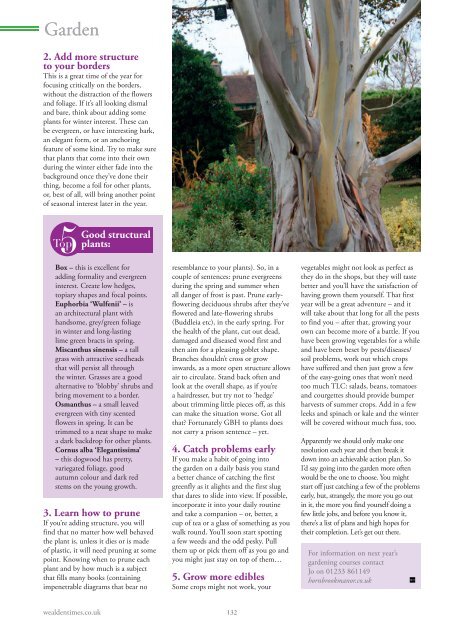Wealden Times | WT179 | January 2017 | Health & Beauty supplement inside
Wealden Times - The lifestyle magazine for the Weald
Wealden Times - The lifestyle magazine for the Weald
Create successful ePaper yourself
Turn your PDF publications into a flip-book with our unique Google optimized e-Paper software.
Garden<br />
2. Add more structure<br />
to your borders<br />
This is a great time of the year for<br />
focusing critically on the borders,<br />
without the distraction of the flowers<br />
and foliage. If it’s all looking dismal<br />
and bare, think about adding some<br />
plants for winter interest. These can<br />
be evergreen, or have interesting bark,<br />
an elegant form, or an anchoring<br />
feature of some kind. Try to make sure<br />
that plants that come into their own<br />
during the winter either fade into the<br />
background once they’ve done their<br />
thing, become a foil for other plants,<br />
or, best of all, will bring another point<br />
of seasonal interest later in the year.<br />
5<br />
Top<br />
Good structural<br />
plants:<br />
Box – this is excellent for<br />
adding formality and evergreen<br />
interest. Create low hedges,<br />
topiary shapes and focal points.<br />
Euphorbia ‘Wulfenii’ – is<br />
an architectural plant with<br />
handsome, grey/green foliage<br />
in winter and long-lasting<br />
lime green bracts in spring.<br />
Miscanthus sinensis – a tall<br />
grass with attractive seedheads<br />
that will persist all through<br />
the winter. Grasses are a good<br />
alternative to ‘blobby’ shrubs and<br />
bring movement to a border.<br />
Osmanthus – a small leaved<br />
evergreen with tiny scented<br />
flowers in spring. It can be<br />
trimmed to a neat shape to make<br />
a dark backdrop for other plants.<br />
Cornus alba ‘Elegantissima’<br />
– this dogwood has pretty,<br />
variegated foliage, good<br />
autumn colour and dark red<br />
stems on the young growth.<br />
3. Learn how to prune<br />
If you’re adding structure, you will<br />
find that no matter how well behaved<br />
the plant is, unless it dies or is made<br />
of plastic, it will need pruning at some<br />
point. Knowing when to prune each<br />
plant and by how much is a subject<br />
that fills many books (containing<br />
impenetrable diagrams that bear no<br />
resemblance to your plants). So, in a<br />
couple of sentences: prune evergreens<br />
during the spring and summer when<br />
all danger of frost is past. Prune earlyflowering<br />
deciduous shrubs after they’ve<br />
flowered and late-flowering shrubs<br />
(Buddleia etc), in the early spring. For<br />
the health of the plant, cut out dead,<br />
damaged and diseased wood first and<br />
then aim for a pleasing goblet shape.<br />
Branches shouldn’t cross or grow<br />
inwards, as a more open structure allows<br />
air to circulate. Stand back often and<br />
look at the overall shape, as if you’re<br />
a hairdresser, but try not to ‘hedge’<br />
about trimming little pieces off, as this<br />
can make the situation worse. Got all<br />
that? Fortunately GBH to plants does<br />
not carry a prison sentence – yet.<br />
4. Catch problems early<br />
If you make a habit of going into<br />
the garden on a daily basis you stand<br />
a better chance of catching the first<br />
greenfly as it alights and the first slug<br />
that dares to slide into view. If possible,<br />
incorporate it into your daily routine<br />
and take a companion – or, better, a<br />
cup of tea or a glass of something as you<br />
walk round. You’ll soon start spotting<br />
a few weeds and the odd pesky. Pull<br />
them up or pick them off as you go and<br />
you might just stay on top of them…<br />
5. Grow more edibles<br />
Some crops might not work, your<br />
vegetables might not look as perfect as<br />
they do in the shops, but they will taste<br />
better and you’ll have the satisfaction of<br />
having grown them yourself. That first<br />
year will be a great adventure – and it<br />
will take about that long for all the pests<br />
to find you – after that, growing your<br />
own can become more of a battle. If you<br />
have been growing vegetables for a while<br />
and have been beset by pests/diseases/<br />
soil problems, work out which crops<br />
have suffered and then just grow a few<br />
of the easy-going ones that won’t need<br />
too much TLC: salads, beans, tomatoes<br />
and courgettes should provide bumper<br />
harvests of summer crops. Add in a few<br />
leeks and spinach or kale and the winter<br />
will be covered without much fuss, too.<br />
Apparently we should only make one<br />
resolution each year and then break it<br />
down into an achievable action plan. So<br />
I’d say going into the garden more often<br />
would be the one to choose. You might<br />
start off just catching a few of the problems<br />
early, but, strangely, the more you go out<br />
in it, the more you find yourself doing a<br />
few little jobs, and before you know it,<br />
there’s a list of plans and high hopes for<br />
their completion. Let’s get out there.<br />
For information on next year’s<br />
gardening courses contact<br />
Jo on 01233 861149<br />
hornbrookmanor.co.uk<br />
wealdentimes.co.uk<br />
132


















